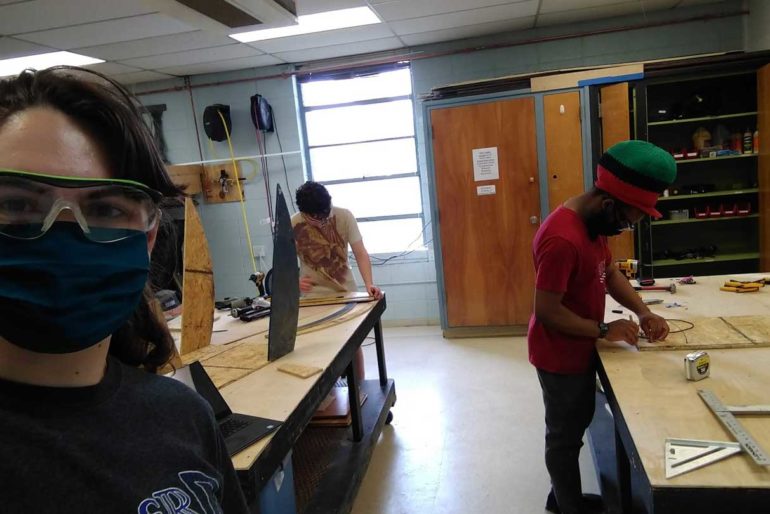[Photo: From left, team members Nadia Alexander, Tegan Ruffalo and Jay Hayman build a prototype in the early manufacturing process. (COURTESY NADIA ALEXANDER)]
APR 16, 2021 | Jim Steele
A unique storage system for a U.S. Navy Submersible developed by a senior design class team in the Department of Mechanical and Aerospace Engineering (MAE) at The University of Alabama in Huntsville (UAH) will be in the running for actual Navy use.
“I have had teams work with the U.S. Special Operations Command in previous years, and this is a continuation of that partnership,” says Dr. Christina Carmen, a clinical associate professor who teaches MAE 490-491 at UAH, a part of the University of Alabama System.
“It is a unique partnership, as it enables UAH students to have the opportunity to work directly with U.S. Department of Defense (DoD) customers and, in turn, the DoD is provided with excellent designs that they may choose to incorporate into their systems for U.S. military personnel.”
Team lead Nadia Alexander, a mechanical engineering major from Rochester, Minn., says the project is “super cool” and the team is having a great time working on it.
“Our understanding is that we are the only team working on this project,” Alexander says. “At the end of the day I’m excited that the ideas and the hard work of my team will be seen by the submersible operators and that some of our ideas may become part of the design for future submersibles.”
Besides Alexander, team members are Jay Hayman, a mechanical engineering major from Memphis, Tenn.; Tegan Ruffalo, a mechanical engineering major from Huntsville, Ala.; Christopher Smith, an aerospace engineering major from Charlotte, N.C.; Kayli Wood, a mechanical engineering major from Austin, Texas; and Nic Shelton, a mechanical engineering major from Meridianville, Ala.
The team was given a list of objects that need to be stored on the submersible and some pictures of what the interior looked like.
“We just rolled with it,” Alexander says. “We essentially determined every location where there was a small amount of space and said, ‘Can we fit something here?’ and then designed a storage solution for that space.”
Students meet with the customer every few weeks to present the various stages of the project and ensure that the team is still on the right track and within the requirements.
“Before the first meeting, we were told the general idea of what the customer is looking for and then we sent them a questionnaire to determine the requirements,” Alexander says. “From there, we made a few preliminary designs, determined which one we wanted to pursue, then proceeded with the rest of the engineering process to bring the product to life.”
The goal is to deliver a final, usable product to the customer. It’s been a fluid process and the storage solution design the team is currently manufacturing bears very little resemblance to its initial design.
“We determined spaces that needed to remain clear, objects that needed priority access, and we designed for comfort as well as practically,” she says.
Throughout the life cycle of the project there have been technical analyses done of the parts through finite element analysis, Alexander says, as well as calculations as to how the added weight may affect the balance of the craft and how to account for that.
“Once the manufacturing is completed, the product will undergo load and fatigue testing,” she says. “Once it is delivered to the customer, it will then undergo operational testing to ensure that it can be used as intended in its operational environment.”
Besides the design challenges, Alexander says the team faced hurdles from the pandemic.
“One of the largest hurdles we had to overcome was the inability to travel,” she says. “Being able to travel would have been really helpful to truly understand the point of view of the operators, outside of some pictures and drawings. In addition, the team experienced delayed parts delivery, which shortened the time available for manufacturing.”
After a product readiness review, the product will be shipped to the Navy for testing in the operational environment of a submersible. The students’ semester concludes with a product certification review that will convey final testing and cost results.
Alexander says the class blends all of her team’s previous engineering education.
“There are the big things like evaluation matrices and working through iterative designs, then there are the things that sneak up on you, like considering off-gassing due to material interactions and how adding components can affect the existing interfaces. It’s always important to keep in mind that even though something may look good on a CAD, you have to think about exactly how someone will use it, as well as build it,” she says.
“One of my biggest takeaways definitely comes from the scheduling aspect, and how to deal with the issues that arise in a calm manner, and not let any one aspect overshadow the rest of the project,” Alexander says.
“I’m very lucky to be working with such an amazing team full of people ready to step up and help out their fellow teammates. Everyone had great ideas that blended together into a really cool product. We did great work, and we had a fun time doing it. It was a joy to work with such fantastic people.”

